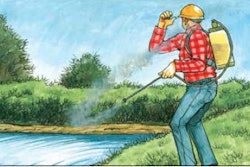Beetles and scales can plaque ornamentals, making them appear thin, underdeveloped and robbing them of color and vigor, at best. One of the most damaging ornamental pests, beetles are most harmful in the larval or grub stage, when they feed on roots. Adults can contribute to destruction, too, though, especially by feeding on flowers and foliage.
· Bark beetles and borers concentrate on the bark and vascular tissue of the plant. Borers are grub beetles that embed themselves into the woody parts of trees and shrubs and feed on the wood. You can identify their presence by looking for small holes in branches where they have entered the plant. Further exploration of the branches may even reveal where they have tunneled within the plant. Bark beetle grubs leave their mark in much the same way, and can often by identified by their tunneling, which results in intricate patterns just underneath the bark.
Treating bark beetles and borers is not easy because they are heavily protected under the bark of the plant. However, it is possible. If you’re looking to control these pests with insecticides, you need to time treatments so that they coincide with egg laying and hatching, usually in spring or early summer. Doing so prevents newly hatched borers from gaining entrance. Some products that are designed to control borers include acephate, chlorpyrifos and imadicloprid (Merit). Acephate is a spray insecticide that also can be injected into the trunk. Chlorpyrifos is available in both spray and granular formulations. Imadicloprid comes in a spray, a granular and also can be injected.
Another way to combat bark beetles and borers is to unleash parasitic nematodes on them. This method of control is cost effective, even though results may not be as immediate as your client might like. However, using nematodes gives you more flexibility in treatment times, and these parasites keep working on borers even inside the plant.
· Japanese beetles are a serious threat to turf and ornamentals. In the grub stage, they eat the roots of both. In the adult stage, they chomp away at foliage and can cause extensive damage, which is evident even without close inspection.
Your first treatment option is to knock out grubs in turf. Doing so will obviously cut down on adult numbers later. Otherwise, you’ll need to apply a foliar insecticide to help prevent adults from feeding on ornamentals.
Scales most vulnerable in the crawler stage of development
With sucking/piercing mouth parts, these enemies of ornamentals can withdraw large amounts of plant fluids, affecting plant vigor and, in severe cases of infestation, result in the plant’s death. There are many species of scales. Some are soft-bodied insects with a hard “shell-like” covering. Others are unarmored and don’t have a covering. The category also includes mealybugs, which are covered with a white, mealy wax. And most plants are susceptible to at least one kind of scale.
While the pests themselves may be hard to spot (they are well camouflaged amongst the bark and branches and are easily overlooked), evidence of their presence is usually obvious in the form of sticky honeydew on foliage. This is followed by the growth of sooty molds on leaf surfaces.
Due to their extraordinary ability to multiply, scales can be extremely difficult to control. They are most vulnerable at the crawler stage, as they are moving from one feeding site to another. At this stage, they don’t have a protective covering and are most susceptible to insecticides. Apply sprays after the majority of crawlers have emerged. Some products labeled to control scales in ornamentals include bifenthrin (Talstar and other brands), carbaryl (Sevin) and imidacloprid (which can be injected into the trunk). Remember: Before applying any pesticide, refer to the label and follow directions.
As with turf, keep in mind that healthy ornamentals not only will be able to tolerate these pests better, but may not attract them in the first place. There is evidence that some insect pests can actually detect stressed plants and attack them preferentially.
USDA amends sudden oak death regulations
The U.S. Department of Agriculture’s Animal and Plant Health Inspection Service has published an interim rule that will help prevent the spread of Phytophthora ramorum, commonly referred to as sudden oak death, to non-infested areas of the United States.
The new measures establish restrictions on the interstate movement of nursery stock from nurseries in non-quarantined areas in California, Oregon and Washington, and restrict the interstate movement of all nursery stock from nurseries in quarantined areas. The amendments also update conditions for the movement of regulated articles of nursery stock from quarantined areas and add restrictions on the movement of decorative trees without roots from quarantined areas. The regulation change also lists new hosts of the pathogen that infects nursery plants and can cause mortality in oak and tanoak trees.
The disease was first seen in Mill Valley, California., on an oak in 1995. The fungus-like organism is now known to be established in 14 northern California counties and part of Curry County, Oregon. In February 2002, APHIS quarantined 10 California counties and the affected areas of Curry County and began regulating the interstate movement of P. ramorum hosts.








